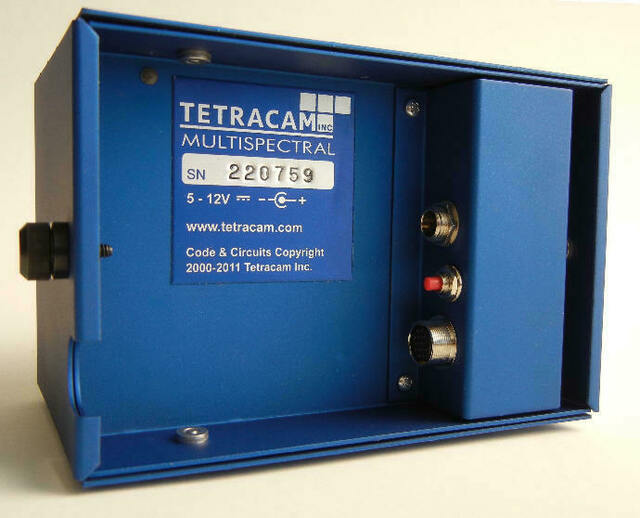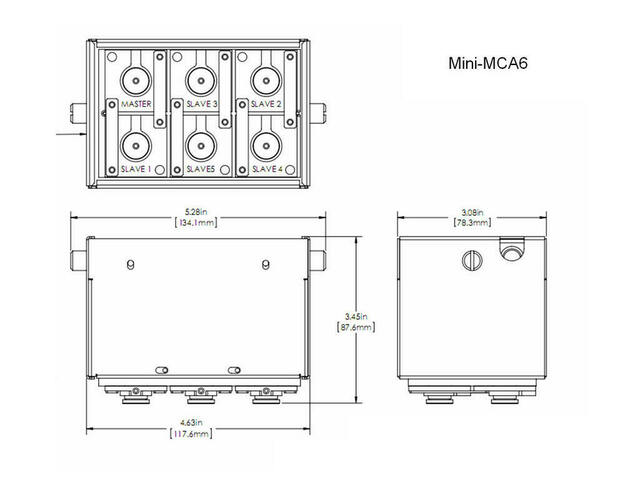MINI-MCA
(Miniature Multi-Camera Array)
(PLEASE USE INNER SCROLL BAR
TO VIEW THIS ENTIRE PAGE)
|
Note: This product is no longer in production. It has been replaced by the Micro-MCA |
|||

The Mini-MCA is a lightweight, compact version of the MCA (Multiple Camera Array) imaging system. The outstanding feature of the Mini-MCA is that it is customizable. Users can equip a Mini-MCA camera with specific narrow-band filter combinations of their own choosing in order to, for example, differentiate between stressed and healthy vegetation of a specific species. And, because Mini-MCA filters may be changed in the field, these systems may be re-purposed again and again to detect different wavelengths at different times for different purposes.
Mini-MCAs are available in three standard models identified as the Mini-MCA4, Mini-MCA6 and Mini-MCA12. These capture four, six and twelve channels respectively of 10 bit SXGA (1.3 megapixel) data. Each Mini-MCA channel has it's own image sensor/bandpass filter/lens combination mounted in a common, factory aligned optical block.
The camera's image sensor's output is optimized for receipt of wavelengths around approximately 800nm dropping in a smooth curve to 20% peak output at 450 nm in the visible spectrum and 1050 nm in the near-infrared at the limits of its range. A graph of the sensitivity of the camera's image sensor to impinging radiation is shown below.

By choosing a specific narrow band optical filter that is within the sensor's range to place in front of each channel's image sensor, the radiation that is able to reach each sensor may be restricted to a specific narrow band of wavelengths. In this way, specific filter combinations may be selected that allow the Mini-MCA to expose differences between stressed and healthy vegetation (see example graph below), individual plant species, different stages of growth of a single species or to determine the presence or absence of a specific chemical compound identifiable by its own unique spectral signature. Note: an excellent reference describing the unique spectral signatures of numerous plant species is "Hyperspectral Remote Sensing of Vegetation" by Prasad Thenkabail, et al. available from Tetracam). For an additional spectral resource for minerals, man-made materials and vegetation, reference the USGS Spectral Libtrary at http://speclab.cr.usgs.gov/spectral.lib06/ds231/datatable.html or selectred readings at http://www.tetracam.com/Support.htm

Alternatively, the Mini MCA may be set up to monitor specific bands of wavelengths from which vegetation indices may be extracted. For example, the standard configuration of a Mini-MCA4 includes filters that approximate four of the Landsat Thematic Mapper (TM) bands corresponding to:
Band TM Range Narrow Band Filter Description
TM Band 1 (450 - 520 nm) - 470 nm (470FS10) - Blue
TM Band 2 (520 - 600 nm) - 550 nm (550FS10) - Green
TM Band 3 (630 - 690 nm) - 660 nm (660FS10) - Red
TM Band 4 (760 - 900 nm) - 810 nm (810FS10) - NIR
These provide information needed for extraction of NDVI, SAVI and other indices. The filter pass bands provided with the unit are customer designated at the time of order. These may be easily changed in the field. Filters approximating TM bands 1 - 4 are included in the price of the unit (see Specifications below). Alternative band pass filters are available upon request with prices provided via a quotation. See chart here (courtesy of Geo-Konzept of Germany) for a broader list of the center wavelengths of common filters used to derive more vegetation indices.
| The Mini-MCA is a modular system that allows the end user to combine and sync multiple Mini-MCA units together. Systems of four, six or twelve channels may be cascaded together for capturing images at the same time. Individual sensors may be removed from modules to provide the precise number of channels required. Included software, PixelWrench2, allows precise pixel-alignment of each of the captured images. The Mini-MCA's field of view (FOV) is laid out in a 4:3 format. When carried in a manned or unmanned aircraft, the field of view increases as the above ground level (AGL) altitude increases. As the AGL increases, the camera's ability to resolve individual details on the ground decreases. With its standard 9.6 mm lens, when flown at altitude of 400 feet above ground level, each Mini-MCA channel creates an image large enough to capture nearly one and one-half acres at a resolution of approximately two and a half inches per pixel in a single shot! |
 |
Mini-MCA (with 9.6 mm Lens)
Ground Resolution & FOV Examples
Sensor & Lens Parameters |
Object Distance (Altitude Above Ground Level in meters) |
Ground Resolution in mm per pixel |
FOV (width x height) in meters |
The values shown at right were derived from the FOV (Field of View) Optical Calculator contained in Tetracam's PixelWrench2 software (included with all Mini-MCA cameras) using the current values for the Mini-MCA camera shown below: Sensor Dimensions (mm): 6.66 x 5.32 Pixel Size (microns): 5.2 Camera Lens Focal Length (mm): 9.6 |
122 m (~ 400 ft) |
66 |
84 x 67 |
213.4 m (~ 700 ft) |
116 |
148 x 118 |
|
365.8 m (~ 1200 ft) |
198 |
254 x 203 |
|
915 m (~ 3000 ft) |
496 |
635 x 508 |
Mini-MCA image systems feature fast USB interfaces (located behind access panel on the Mini-MCA) and non-volatile image storage on standard Compact Flash cards (one per channel). Software supplied with the camera provides full camera control as well as image management and analysis. The system can be connected to an external GPS receiver speaking NMEA sentences. Camera coordinates at capture time are then attached to the image data and later recovered using the PixelWrench2 software.
 |
Mini-MCA image Connectors & Controls on the back of the unit include: Power – Link to 12VDC center positive supply capable of delivering 0.5 Amps continuous. The supplied wall-plug type supply connects to this jack. Camera Trigger - Red button that when pushed triggers camera to capture image. In aircraft, images are captured by commands delivered through the Multi-IO connector Multi I/O – 16-pin connection to the Camera Controller for viewing video, navigating the menu, taking pictures, and connecting GPS. This connects via a 16-pin Hirose cable to an ADC-MCA Button Box supplied with the Mini-MCA. The button box enables remote control of the Mini-MCA's system menus and two connectors supplying NTSC or PAL video out for remote viewing of the observed image and an RS232 serial input for connection to a GPS receiver. |
Due to it's specialized nature, the Mini-MCA is built to order. Please contact us for more information regarding configuration options and pricing.
Typical Availability: 3 to 4 weeks - faster turnaround times are often possible so please call to confirm.
Features and Specifications
![]() Features
Features
![]() Specifications
Specifications
- 1.3 megapixels (Per Channel) Image size
for excellent ground resolution.
- Video out and standard GPS data
capture from an external receiver.
- User interchangeable filters. Mini-MCA filters are customer designated at the time of order. They are easily field replaceable using standard 25mm spectrometer filters. Note: Since wavelength impacts focus, a replacement filter should only replace a filter that is near the wavelength of the filter originally installed in the system in that channel position. In the visible spectrum, replacing a filter with a new one that is within plus or minus 100 nm of the original is acceptable. Beyond 700 nm, replacement filters should be within plus or minus 50 nm of the original. Replacement of filters beyond this range requires factory re-focusing of the unit.
- The optional SensorLink GPS waypoint triggering
application enables camera triggering at pre-defined
waypoints.The system can be connected to an external GPS receiver speaking NMEA sentences, camera coordinates at capture time are then attached to the image data and later recovered using PixelWrench2.
- Uses standard Compact Flash Memory
cards
- Powerful PixelWrench2 image editing
software with several tools specific to
multi-spectral images and Tetracam cameras.ADC-MCA Button Box (see Hardware Accessories)
Download the Mini MCA Brochure (2.97MB)
Note: the physical appearance and the dimensions of the Mini-MCA 4, 6 and 12 systems were updated in 2011. Those shown in the photos and drawings on this web page supercede those shown in the current Brochure and Users Manual. |
Contact your Tetracam Reseller for additional information and pricing or contact Tetracam direct at info@tetracam.com.
List of files on included CD:
SXGA (1280 x 1024) 1.3 megapixel CMOS sensor, 1 per channel.
- 25 mm standard spectrometer filters, 1 per channel.
- Image storage to Compact Flash in Tetracam DCM, 8bit and 10bit RAW formats.
- USB interface.
- Multipin I/O connector for use with Tetracam remote trigger and viewer accessories.
- Lightweight aluminum enclosure.
- Image Capture:
Capacity: Approx. 1 MB per image, limited only by CF card size.
Rate: Single Shot - Capture to end of compression and write:
3-5 seconds.
Burst Mode -1.3 frames per second until buffer full.
-
Shutter type: Rolling shutter
- Inputs:
Typical 12 VDC @ 1A (See Power Detail below)
RS-232 dedicated to capture of NMEA GPS sentences.
External Trigger.
- Outputs:
Realtime NTSC or PAL Video for both viewfinder and menu operations.
- Data Interface:
USB 1.1
- Dimensions
Dimensions shown in the drawings below supercede those values shown in the User Manual and brochure. -
Weight
1.32 lbs. (600 g) (Mini-MCA 4)
1.54 lbs. (700 g) (Mini-MCA 6)
2.87 lbs. (1300 g) (Mini-MCA 12) -
Power Detail
All Mini-MCA cameras are equipped with switching power supplies so they can operate with variable voltage inputs ranging from +6 to +12 volts DC. At 12 volts, the nominal current draw of the Mini-MCA 6 is 400 milliamps. This increases to 450 milliamps when the unit is capturing images or writing data to its memory. At 6 volts, the Mini-MCA 6 draws 700 milliamp which increases to 800 milliamps during image capture or storage.
- System Includes:
MCA Camera, 1 filter and 9.6 mm lens per channel
2GB CF cards (1 per channel)
USB Cable
Remote Trigger unit
AC/DC power supply
DC power cableRugged carrying case
Tetracam PixelWrench2 Application Software (for Windows)
Software Calibration TileThe standard set of filters included with the Mini-MCA-4 include the following bands:
470-10
550-10
660-10
810-10The standard set of filters included with the Mini-MCA-6 include the following bands:
470-10
550-10
660-10690-10
710-10
810-10Alternative band pass filters are available upon request with prices provided via a quotation
Mechanical Drawings and Photos




MIni-MCA6 Multispectral Images

